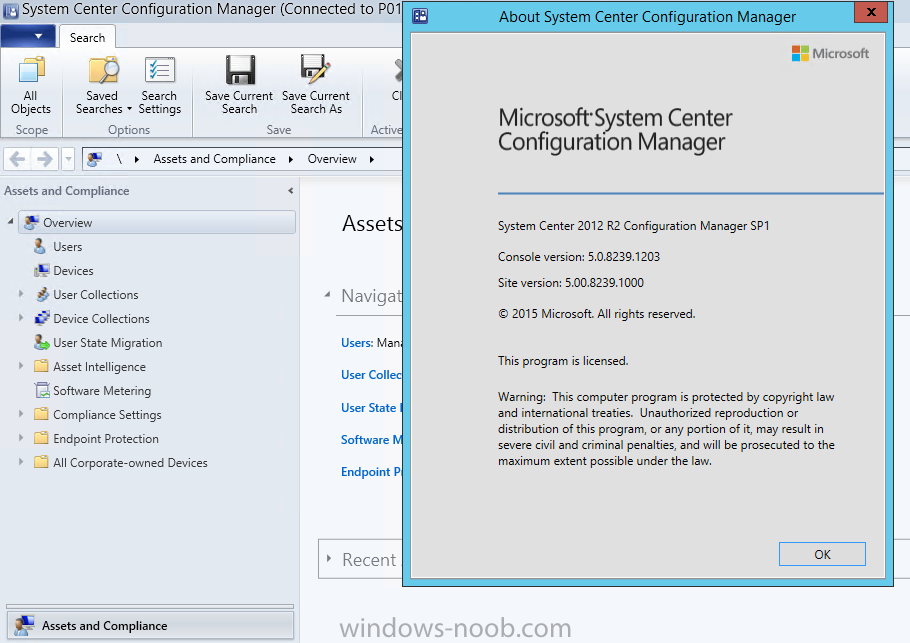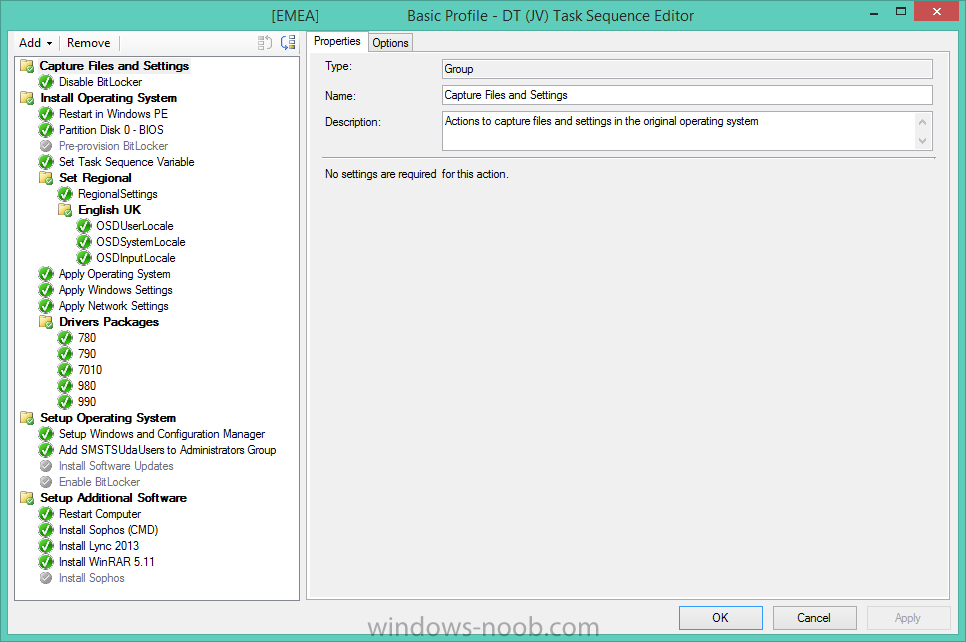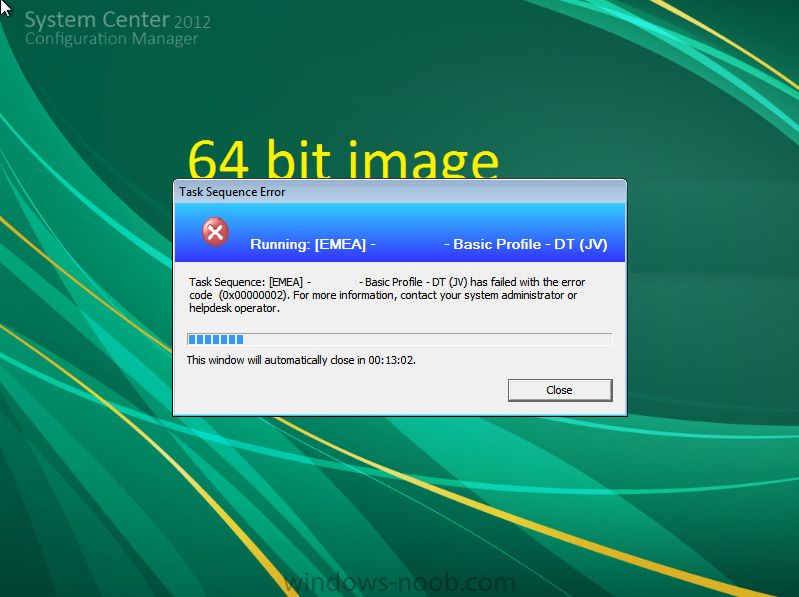
Vini
Established Members-
Posts
22 -
Joined
-
Last visited
Everything posted by Vini
-
I'm looking to include a Recovery Partition/Restore Point post deployment. Something that will allow our users who find themselves suffering issues when out in the field, the ability to "restore" to OOTB state. My image at the minute is dynamic, I use the clean Windows 10 'install.wim' and then layer everything on top during the task sequence, the image is built to "spec" based on options the user provides during the deployment. After reading this thread (linked below), the suggestion is that you need/want to include the .wim file for use with the recovery partition. Of course, if I was to do that, my user would end up with a clean Windows 10. Do I need to consider switching from a dynamic image to a fat .wimfile, or are there other options that I can consider??
-
I currently administer a single, on-premise, MP with ~60 local DPs spread globally. We have around 7500 devices and 4000 users. At present the MP, SQL and foundations all live in the UK, and this is causing a bit of grief for our APAC sites, when pulling down TS policies for OSD etc... We're needing/wanting to spin up a 16xx instance of SCCM anyway, but have been wondering if/how feasible a Cloud Based MP and feature rich site system server would be if based in Azure for example. The rough plan would be... MP (Azure VM, EMEA) DB (Azure SQL, EMEA) DP (Azure VM, 1 per region - EMEA, NASA & APAC) Source Server (Azure VM) We'd use the Azure Based DP's as "Push" DP's, to the 60 or so Local DPs we have globally. The theory being this would alleviate the stress on our a Single UK DP as the "pusher". Is SCCM ready for this kind of setup? Is Azure ready for this kind of setup? Does anyone else, do anything similar?
-
No mouse pointer during Win 10 task sequence
Vini replied to MadMacs77's topic in Configuration Manager 2012
Thanks! But page not found. Looks like a link to an edit though?? -
No mouse pointer during Win 10 task sequence
Vini replied to MadMacs77's topic in Configuration Manager 2012
Was there ever any solution to this? This only seems to be occurring on my Win 10, UEFI device(s). -
From your log(s). The first hit for 80004005 is; Install application action failed: 'Microsoft Internet Explorer 11 - Install'. Error Code 0x80004005 InstallApplication 11/04/2016 11:33:09 2572 (0x0A0C) Try checking the 'Continue on Error' option, or removing IE11 temporarily and see how it goes. Don't suppose updates have been injected already containing IE11 or something?
-
I've since identified that the Boundary did not have a site server assigned - oops! Since assigning a site server, the error is now 80004005... again this occurs immediately?
-
Ok, part of my testing, I just created a simple Deploy Image TS, and it's still failing immediately. But on a different package. It's like it might not be able to communicate with the DP perhaps? (Although it's booting to it!)
-
Our SCCM environment seems to be catching falling ill... DP/Site after DP/Site are failing to deploy our usually fine task sequence. We started with one site, and now we have 5 of 40 seeing this problem. This is not our video, but the issue is almost identical. The TS bombs out almost immediately. In our example, the package reported is P0100001, which is our first/default package, and in our instance is the USMT tools created by the ADK (User State Migration Tools for Windows 8.1). This package is configured to serve source files from <Directory on site server>C:\Program Files (x86)\Windows Kits\8.1\Assessment and Deployment Kit\User State Migration Tool. The sites that are failing DO have Computer Accounts defined in the MP permissions (RemoteDPServer$). I am not entirely sure where to begin in troubleshooting this. We're focussing on a single site to troubleshoot, believing that it'll either be a golden bullet fix, or a fix we can replicate on those DPs with this issue. So far, we've rebuilt the DP. We've disabled the USMT step in the TS and I'm currently repackaging and redistributing a copy of the USMT package to serve from an SMB share. Any thoughts?
-
I've quite a sizeable TS, and I need to perform some juggling of steps in it, doing it via the GUI in SCCM will take a while. Is there a way of modifying this out of the UI at all?
-
Office 2013 updates "on the fly" during OSD? How??
Vini posted a topic in Configuration Manager 2012
Not having much luck in deploying Office 2013 updates during our TS run. Our TS installs Windows 7, does a first pass of Updates using the inbuilt "Software Updates" step, it then installs applications. I want to apply the "updates" available in WSUS to the installed applications, so I have configured 3 further "update" passes in the TS, none of these pick up the Office 2013 updates. The post-app-install command I'm using is; WMIC /namespace:\\root\ccm path sms_client CALL TriggerSchedule "{00000000-0000-0000-0000-000000000113}" /NOINTERACTIVE How do you ensure your OSD TS is fully updated during its run? It's worth noting, that the TS joins the domain early on, so I assume it has our WSUS GPO active... Regardless, the Office updates I want, are approved by our WSUS server... -
Unable to reimage an already active machine...
Vini replied to Vini's topic in Configuration Manager 2012
I assume you mean deployment start time. The deployment start time to the "All Unknown Devices" collection is 25/09/2015 which is almost a week ago. The deployment to "All Active Systems" (a custom Device Collection based on All Systems, whereby only systems with an Active client are included) is the same... The log shows "no advertisement found", but considering I'm deployed to All Unknown and All Active Systems, I don't know what else I could "deploy" to...! This is causing many problems now, specifically during testing. -
Unable to reimage an already active machine...
Vini replied to Vini's topic in Configuration Manager 2012
-
We've recently upgraded to the very latest version of 2012 R2 available, including CU1 (5.00.8239.1000). Since doing that, it seems, we are unable to re-deploy an OS to a Device that is "active" or has been previously deployed. Removing the device from the SCCM Console (and thus DB), allows the OSD process to begin again. Any ideas? Currently the Task Sequence is deployed to Unknown Devices and a collection, in which these previously imaged devices exists.
-
How can I best monitor "application" deployments, and if/when the network grinds to a halt during deployments, how can I best cancel active deployments to clients? The 3rd party tool "Sender Analyser" by Dan Richings looks ideal, at least for monitoring, but it doesn't seem to work in R2, is there anything else on the block...? As an example, I have deployed an application as a requirement to 250 people. I'm being told that I need to immediately halt all deployments. How can I best do that, without pausing/killing the client on everyone's machine.
-
Application install fails, but actually installs ok?
Vini replied to Vini's topic in Configuration Manager 2012
MSI still resulted in the same, so I've been toying with Script Detection. My scripting skills are zero, I'm usually capable of ripping scripts, and altering to make them work, however, in this situation I'm struggling. For this application, I've enabled Script detection. The script is as follows; When the above script is saved as a .ps1 and run locally on a machine which has the software installed, it results in 'Software Installed' being displayed. If I change the version to something that is incorrect, it does not display anything. Which suggests to me that the script is working. However, when enabling this in SCCM, the Application disappears from Software Center, and AppDiscover.log shows; -
Application install fails, but actually installs ok?
Vini replied to Vini's topic in Configuration Manager 2012
I was checking for a file - which I presumed would be the easiest?...but have switched to MSI and Reg, will see how that goes - thanks. -
We have some applications that are 'failing' to install successfully according to Software Center, however, given time they actually do install ok. As far as I can tell the installer we're running is completing with a 0 code, but... the actually installer triggers further installations, which can take time... as such the detection fails, and this (I believe) is causing the app to fail. The AppEnforce logs, What could be done about this? Cheers, James
-
I'm currently getting to grips with SCCM 2012 R2, and have a pressing need to forcefully install OneDrive for Business to approximately 6000 devices. I had a similar requirement to install Lync 2013 across the estate earlier, but our platform was inherited and very sketchy (failed DP's etc), therefore installation was very hit and miss. Other than the flakey platform, I struggled with, Bitness detection of Office. For example, you cannot install mixed-bitness Lync 2013, or OneDrive for Business clients. By this I mean, you cannot install 64 Bit Lync, with 32 Bit Office. But detecting 32 Bit Office is not straightforward, at least it's not to an SCCM newbie, and Microsoft don't seem to make things any easier! We, are not alone I'm sure, in having such a mongrel userbase... We have users running 64 bit Windows, with 32 bit Office, with 64 bit Outlook... We have users running 64 bit Windows, with 32 bit Office 2010, with 64 bit Office 2013... Detecting for a seamless, silent, successful install of these add-on applications, is pretty tricky! At present my detection relies on Registry Entries... x64 Detection OS = 64bit & Office 64bit Detection = True (custom Condition) ( Office 2010 Bitness (Method 1) None of {x86, NULL} OR Office 2013 Bitness (Method 1) None of {x86, NULL} ) OR ( Office 2010 Bitness (Method 2) None of {x86, NULL} OR Office 2013 Bitness (Method 2) None of {x86, NULL} ) x86 Detection ( Office 2010 Bitness (Method 1) Does not contain {x64} OR Office 2013 Bitness (Method 1) Does not contain {x64} ) OR ( Office 2010 Bitness (Method 2) Does not contain {x64} OR Office 2013 Bitness (Method 2) Does not contain {x64} ) Those conditions mentioned above, look like this; (checks registry entries) Office 2010 Bitness (Method 1) SOFTWARE\Microsoft\Office\14.0\Outlook\Bitness Office 2013 Bitness (Method 1) SOFTWARE\Microsoft\Office\15.0\Outlook\Bitness Office 2010 Bitness (Method 2) SOFTWARE\Wow6432Node\Microsoft\Office\14.0\Outlook\Bitness Office 2013 Bitness (Method 2) SOFTWARE\Wow6432Node\Microsoft\Office\15.0\Outlook\Bitness How else might I achieve this? Other than uninstalling * Office and installing 2013 full phat
-
Task Sequence has failed 0x00000002 (Software)
Vini replied to Vini's topic in Configuration Manager 2012
I was able to get an IP in WinPE. So ruled out NIC issues... However, I decided to drop the 'specific' driver packages from the TS, reverting to Auto Apply Best Known, and injected the VMXNET3 nic drivers into the Driver Packages section and also Boot image. Since doing that, the deployment in my VM environment has worked... -
Task Sequence has failed 0x00000002 (Software)
Vini replied to Vini's topic in Configuration Manager 2012
Even if I disable the Add user to Administrators step, I still get the 0x00000002 failure when trying to install Applications. Because its set to continue on fail, click ok will spark a reboot afterwhich I can login to the deployed OS, just it doesn't have the specified software installed -
Task Sequence has failed 0x00000002 (Software)
Vini replied to Vini's topic in Configuration Manager 2012
Funny you say that, just after adding this thread, I changed all 'Network Users' to a domain admin, just to make sure. I'm just running a deploy now... Even without that step though, it still fails. -
Hi all, Hopefully this is pretty straight forward, but this is my first foray into OS deployment with SCCM. I've borrowed a Task Sequence off another user in the company, and made some changes. I'm trying to "Setup Additional Software" so that it installs a few things post install. The software in the TS, is distributed to the Distribution Points, the SCCM Site Computer Account is an Admin on the DP. Whilst deploying the TS, it fails at the Software bit. Any ideas? CAS SMSTS




